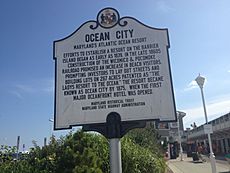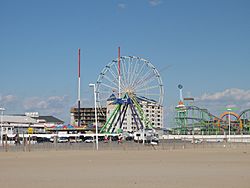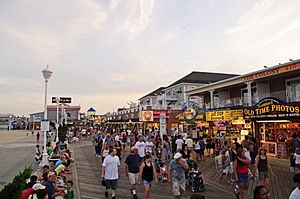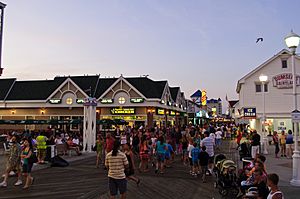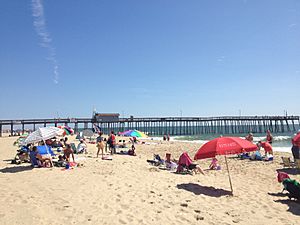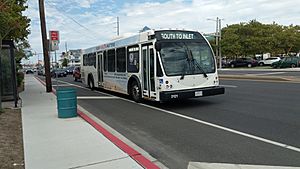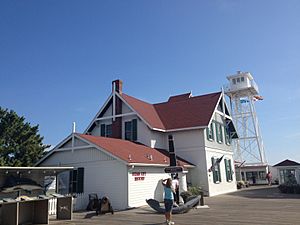Ocean City, Maryland facts for kids
Quick facts for kids
Ocean City, Maryland
|
|||
|---|---|---|---|
| Town of Ocean City | |||
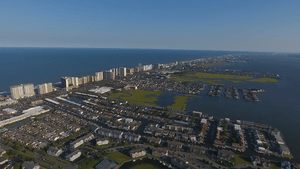
Ocean City in July 2018
|
|||
|
|||
| Nickname(s):
"The White Marlin Capital of the World", "OC", "OCMD"
|
|||
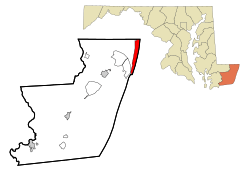
Location in Worcester County and the state of Maryland
|
|||
| Country | United States | ||
| State | Maryland | ||
| County | Worcester | ||
| Founded | 1875 | ||
| Incorporated | 1880 | ||
| Government | |||
| • Type | Council-manager | ||
| Area | |||
| • Total | 9.65 sq mi (24.99 km2) | ||
| • Land | 4.53 sq mi (11.73 km2) | ||
| • Water | 5.12 sq mi (13.25 km2) 53.05% | ||
| Elevation | 7 ft (2 m) | ||
| Population
(2020)
|
|||
| • Total | 6,844 | ||
| • Density | 1,510.48/sq mi (583.22/km2) | ||
| 320,000–345,000 estimated summer weekend population | |||
| Time zone | UTC−5 (Eastern) | ||
| • Summer (DST) | UTC−4 (Eastern) | ||
| ZIP Codes |
21842–21843
|
||
| Area code(s) | 410, 443, and 667 | ||
| FIPS code | 24-58225 | ||
| GNIS feature ID | 0586284 | ||
| Website | www.oceancitymd.gov | ||
Ocean City, officially the Town of Ocean City, is an Atlantic resort town in Worcester County, Maryland, United States. Ocean City is a major beach resort area along the East Coast of the United States. The population was 7,102 at the 2010 U.S. census, although during summer weekends the city hosts between 320,000 and 345,000 vacationers, and up to 8 million visitors annually. During the summer, Ocean City becomes the second most populated municipality in Maryland, after Baltimore. Located on Fenwick Island, it is part of the Salisbury, MD-DE Metropolitan Statistical Area, as defined by the United States Census Bureau.
Contents
History
The land upon which the city was built, as well as much of the surrounding area, was obtained by Englishman Thomas Fenwick from the Native Americans. In 1869, businessman Isaac Coffin built the first beach-front cottage to receive paying guests. During those days, people arrived by stage coach and ferry. They came to fish off the shore, to enjoy the natural beauty of the Atlantic Ocean pounding against the long strip of sandy beach, to collect seashells, or just to sit back and watch the rolling surf.
Soon after, other simple boarding houses were built on the strip of sand, with the activity attracting prominent businessmen from the Maryland Eastern Shore, Baltimore, Philadelphia, and Wilmington. They came not so much to visit as to survey the spit. A decision was made to develop it and 250 lots were cut into it, and a corporation was formed to help with the development of the land. The corporation stock of 4,000 shares sold for $25 each.
Prior to 1870, what is now Ocean City was known as "The Ladies' Resort to the Ocean."
The Atlantic Hotel, the first major hotel in the town, opened July 4, 1875.The Atlantic Hotel was originally owned by the Atlantic Hotel Company, but eventually Charles W. Purnell bought it in 1923. It is still currently owned and operated by the Purnell family. Besides the beach and ocean, it offered dancing and billiard rooms to the visitors of its more than 400 rooms, and for years it was the northern-most attraction in Ocean City. By 1878 tourists could come by railroad from Berlin to the shores of Sinepuxent Bay across from the town. By 1881, a line was completed across Sinepuxent Bay to the shore, bringing rail passengers on the Baltimore, Chesapeake and Atlantic Railroad directly into the town to a train station on Philadelphia Avenue and returning to larger city markets with locally caught fish from Ocean City.
The Ocean City Inlet was formed during a significant hurricane in 1933, which also destroyed the train tracks across the Sinepuxent Bay. The inlet separated what is now Ocean City from Assateague Island. The Army Corps of Engineers took advantage of nature's intervention and made the inlet at the south end of Ocean City permanent. The inlet eventually helped to establish Ocean City as an important Mid-Atlantic fishing port as it offered easy access to the fishing grounds of the Atlantic Ocean.
In the late 1930s, the Army Corps of Engineers dredged a new channel on the bayside of Ocean City to allow larger boats to have access to Sinepuxent Bay. The dredge was pumped back onto the western shore of Ocean City allowing the creation of Chicago Avenue and St. Louis Avenue, leading to new development where previously only marshland had been.
Ocean City has become a well-known city in Maryland due to the rapid expansion of Ocean City that took place during the post-war boom. In 1952, with the completion of the Chesapeake Bay Bridge, Ocean City became easily accessible to people in the Baltimore–Washington metropolitan area. In 1964, with the completion of the Chesapeake Bay Bridge-Tunnel, a whole new pathway to the south was opened. Ocean City became one of the largest vacation areas of the East Coast.
By the 1970s, big business flourished and gave birth to the construction of more than 15,000 condominium units, creating a spectacular sight of high-rise condominiums that assured every investor of a glimpse of the ocean and pounding surf. However, throughout the 1980s, and into the 1990s, the width of the beach began to shrink, prompting the first of a series of beach replenishment projects.
The original pier was destroyed by a fire in 1994. There was a small water park and giant walk-through haunted house with live actors near the end of the pier and a New Orleans-style Hollywood in Wax Museum on the boardwalk side. In the late 1980s the Wax Museum was turned into a Photon laser tag arena. The building now houses the Ripley's Believe it or Not! museum.
In 2002, Ocean City undertook the most recent of many, multimillion-dollar, beach restoration programs, in an attempt to slow the westward migration of its beaches. The program pumped tons of sand from offshore and deposited it onto the beach. A dune line was also re-established in front of Ocean City's building line. Another similar project began after the 2006 tourist season closed.
The Sandy Point Site and St. Paul's by-the-sea Protestant Episcopal Church are listed on the National Register of Historic Places.
Recent history
Today, the Ocean City area continues to sprawl westward across the bay and toward Berlin and Ocean Pines. It was part of the Ocean Pines Micropolitan Statistical Area until that was subsumed by the Salisbury Metropolitan Area. The resort area accommodates approximately 8 million visitors per year.
The town supports a year-round population of about 8,000, with the town itself being a major employer. Summer employment in Ocean City rises many multiples above that level, supported by a large number of college-age and young adults - many native to Eastern Europe and Ireland - attracted by numerous job opportunities. In the summer, businesses and government agencies are augmented with about 100 seasonal police officers, plus extra firefighters and other workers.
Tourism in the off-season has picked up pace over the past decade. Today, Ocean City, Maryland has become one of the most popular vacation areas of the East Coast. Warmer months like June, July, and August attract the most tourists due to the opening of the beaches as well as the many different activities available to do. A "shoulder-season" has been established that ranges in the spring from St. Patrick's Day until Memorial Day Weekend and in the fall from Labor Day Weekend until late October. Many establishments stay open into November and December depending on local events and weather. Numerous special events take place within the town during this shoulder-season, including Sunfest, Springfest, Bike Week, Cruisin' Weekend, Winterfest of Lights and Reach the Beach, which take place on the Boardwalk and/or in the Roland E. Powell Convention Center. Increased traffic from golfers and these special events have convinced many seasonal restaurants and hotels to open sooner and close down later in the year.
In 2006, the city erected the Ocean City Firefighter's Memorial to honor local firefighters as well as firefighters who died in the September 11 attacks. In addition to a statue of a firefighter, the monument incorporates a piece of steel beam from one of the towers destroyed at the World Trade Center. Ocean City is home to the annual Maryland State Firefighters Convention. This is a week-long event in June, that honors the state's firefighters with events and contests at the Convention Center, and ends with a parade.
Northern Ocean City houses many high-rise beachfront condominiums and hotels such as Century I, The Seawatch, Golden Sands Club, and The Carousel. This area is easily recognizable because of its city-like skyline.
Geography
Ocean City is located at 38°23′29″N 75°04′11″W / 38.391526°N 75.069712°W.
According to the United States Census Bureau, the town has a total area of 36.37 square miles (94.20 km2), of which, 4.41 square miles (11.42 km2) is land and 31.96 square miles (82.78 km2) is water.
Ocean City is on the barrier spit called Fenwick Island, which encompasses Ocean City, South Bethany, Delaware, and Fenwick Island, Delaware. Ocean City's southern point is an inlet formed by the 1933 Chesapeake–Potomac hurricane. Rainfall and tides swelled the rivers and bays surrounding Ocean City until the overflowing water cut a 50-foot crevasse from the bay to the ocean. Ocean City businessmen had long sought funding to create an inlet to support a harbor, so residents seized upon the opportunity and built jetties to ensure the city's land remained divided from what is now Assateague Island.
Climate
Ocean City has a humid subtropical climate (Köppen Cfa), with hot, humid summers, cool winters, and precipitation fairly evenly distributed throughout the year. Due to its location on the Atlantic coast, daytime temperatures in spring and summer are moderated, with an average of only 10 days annually reaching 90 °F (32 °C). Conversely, in winter there is an average of 5.8 days where the temperature fails to rise above freezing.The temperature usually falls between 27 and 85 degrees Fahrenheit, and is very rare to ever fall below 16 degrees Fahrenheit or rise above 91 degrees Fahrenheit. However, in 2010 the temperature rose to 103 degrees Fahrenheit, which was the highest recorded temperature in history. The coldest temperature ever recorded was -6 degrees Fahrenheit in 1957. The prominence of the Outer Banks of North Carolina to the south means direct hits from tropical storms and hurricanes are rare, although they sometimes brush the area.
| Climate data for Ocean City, Maryland | |||||||||||||
|---|---|---|---|---|---|---|---|---|---|---|---|---|---|
| Month | Jan | Feb | Mar | Apr | May | Jun | Jul | Aug | Sep | Oct | Nov | Dec | Year |
| Record high °F (°C) | 77 (25) |
78 (26) |
88 (31) |
94 (34) |
98 (37) |
102 (39) |
103 (39) |
100 (38) |
99 (37) |
94 (34) |
84 (29) |
78 (26) |
103 (39) |
| Average high °F (°C) | 47 (8) |
50 (10) |
58 (14) |
68 (20) |
77 (25) |
85 (29) |
88 (31) |
87 (31) |
82 (28) |
71 (22) |
61 (16) |
51 (11) |
68.75 (20.42) |
| Average low °F (°C) | 28 (−2) |
29 (−2) |
35 (2) |
44 (7) |
53 (12) |
62 (17) |
67 (19) |
65 (18) |
58 (14) |
47 (8) |
39 (4) |
31 (−1) |
46.5 (8.1) |
| Record low °F (°C) | −6 (−21) |
−2 (−19) |
8 (−13) |
22 (−6) |
30 (−1) |
40 (4) |
45 (7) |
41 (5) |
31 (−1) |
22 (−6) |
15 (−9) |
−2 (−19) |
−6 (−21) |
| Average precipitation inches (mm) | 3.57 (91) |
3.26 (83) |
4.52 (115) |
3.48 (88) |
3.52 (89) |
3.47 (88) |
4.39 (112) |
4.90 (124) |
4.40 (112) |
3.53 (90) |
3.52 (89) |
3.67 (93) |
46.23 (1,174) |
| Source: The Weather Channel | |||||||||||||
Demographics
| Historical population | |||
|---|---|---|---|
| Census | Pop. | %± | |
| 1880 | 49 | — | |
| 1890 | 85 | 73.5% | |
| 1900 | 365 | 329.4% | |
| 1910 | 476 | 30.4% | |
| 1920 | 711 | 49.4% | |
| 1930 | 946 | 33.1% | |
| 1940 | 1,052 | 11.2% | |
| 1950 | 1,234 | 17.3% | |
| 1960 | 983 | −20.3% | |
| 1970 | 1,493 | 51.9% | |
| 1980 | 4,946 | 231.3% | |
| 1990 | 5,146 | 4.0% | |
| 2000 | 7,173 | 39.4% | |
| 2010 | 7,102 | −1.0% | |
| 2020 | 6,844 | −3.6% | |
| U.S. Decennial Census | |||
2010 census
As of the census of 2010, there were 7,102 people, 3,852 households, and 1,784 families residing in the town. The population density was 1,610.4 inhabitants per square mile (621.8/km2). There were 30,119 housing units at an average density of 6,829.7 per square mile (2,637.0/km2). The racial makeup of the town was 92.2% White, 2.7% African American, 0.2% Native American, 1.3% Asian, 2.2% from other races, and 1.4% from two or more races. Hispanic or Latino of any race were 5.9% of the population.
There were 3,852 households, of which 11.1% had children under the age of 18 living with them, 36.8% were married couples living together, 6.3% had a female householder with no husband present, 3.3% had a male householder with no wife present, and 53.7% were non-families. 42.8% of all households were made up of individuals, and 17.5% had someone living alone who was 65 years of age or older. The average household size was 1.84 and the average family size was 2.41.
The median age in the town was 54.2 years. 9.1% of residents were under the age of 18; 6.7% were between the ages of 18 and 24; 20.8% were from 25 to 44; 33.8% were from 45 to 64; and 29.6% were 65 years of age or older. The gender makeup of the town was 51.4% male and 48.6% female.
Infrastructure
Transportation

Ocean City has only a single major north−south thoroughfare, Maryland Route 528, known as the Coastal Highway for most of its length, and as Philadelphia Avenue at its southern end. Coastal Highway continues north into Delaware as Delaware Route 1. Between S. 1st Street and 33rd Street, Philadelphia Avenue is paralleled by Baltimore Avenue to the east, which is unsigned Maryland Route 378 south of 15th Street. In downtown Ocean City, Baltimore Avenue is one-way northbound and Philadelphia Avenue is one-way southbound. Most east–west streets are numbered, starting at N. Division Street in the south, and continue until 146th Street at the Delaware/Maryland border. Between S. Division Street and N. Division Street are several streets named after counties on the Eastern Shore of Maryland. South of S. Division Street is S. 1st Street and S. 2nd Street at the Ocean City Inlet. Locations in the city are usually given as Oceanside (east of Coastal Highway) or Bayside (west of Coastal Highway).
Three bridges connect the spit to the mainland. U.S. Route 50 (Ocean Gateway) crosses the Harry W. Kelley Memorial Bridge and connects to MD 528 at N. Division Street. Ocean City is the eastern terminus of US 50. The western terminus of US 50 in West Sacramento, California is a mileage sign stating the distance to Ocean City, MD as 3,073 miles (4,946 km). Maryland Route 90 (Ocean City Expressway), a two-lane freeway, crosses the Assawoman Bay Bridge and connects to MD 528 at 62nd Street. Delaware Route 54 (Lighthouse Road) can also be used to reach Ocean City, as it meets Coastal Highway just north of the border.
The Hugh T. Cropper Inlet Parking Lot is located just north of the Ocean City Inlet adjacent to the beach and boardwalk and offers 1,200 spaces, with paid parking from April to October. The West Ocean City Park and Ride offers free parking, with bus service into Ocean City. There are several smaller paid parking lots and on-street parking enforced by parking meters in the downtown area along with a few paid parking lots in the northern part of Ocean City. Parking lots and parking meters in Ocean City use a pay-by-plate parking system.
Ocean City also has a public transportation system called Ocean City Transportation. This agency operates the Coastal Highway Beach Bus, the West Ocean City Park-N-Ride Beach Bus, the Express Beach Bus for special events, and a trackless train shuttle called the Boardwalk Tram. Ocean City Transportation also offers paratransit service. The Coastal Highway Beach Bus, which operates 24 hours a day, 7 days a week year-round, runs the north–south length of the town along Baltimore Avenue and Philadelphia Avenue in the downtown area and Coastal Highway further north between the South Division Street Transit Center near the Ocean City Inlet and 145th Street near the Delaware border, ending at the 144th Street Transit Center. The West Ocean City Park-N-Ride Beach Bus provides seasonal park and ride service in the summer months from the West Ocean City Park and Ride along U.S. Route 50 in West Ocean City to the South Division Street Transit Center, where connections can be made to the Coastal Highway Beach Bus. The Express Beach Bus operates service for special events throughout the summer months, providing service to events from remote parking areas. The Boardwalk Tram operates during the summer months along the entire length of the Ocean City Boardwalk, using a dedicated path south of 5th Street and running along the boardwalk north of 5th Street.
Ocean City's transit service connects with Shore Transit, where patrons can travel to or from destinations on the Eastern Shore such as from Salisbury and to Pocomoke City along Route 432 and from Pocomoke City and to Salisbury along Route 452. This connection point is the West Ocean City Park and Ride in the summer and the South Division Street Transit Center in the offseason. Between May and September, DART First State's Beach Bus Route 208 bus connects the Coastal Highway Beach Bus at the 144th Street Transit Center with the Delaware Beaches, running to the Rehoboth Beach Park and Ride. Here, connections can be made with other Beach Bus routes, regular DART service, or shuttle service from the Cape May–Lewes Ferry to Cape May, New Jersey.
Greyhound Lines provides intercity bus service between the Baltimore Greyhound Terminal in Baltimore and the West Ocean City Park and Ride, with service on the portion between Salisbury and Ocean City operated by Shore Transit. BayRunner Shuttle offers shuttle service from the Baltimore-Washington International Airport and the BWI Rail Station to the West Ocean City Park and Ride; this service is an Amtrak Thruway Motorcoach route. OurBus provides intercity bus service from Washington, D.C. and Annapolis, Maryland to Ocean City during the summer months, stopping at 60th Street and Coastal Highway.
Ocean City Municipal Airport, located 3 miles (4.8 km) west of downtown Ocean City serves general aviation and charter aircraft. Full service FBO available at this airport, as well as FAA and Cessna Pilot Center approved flight school. Nearby Salisbury-Ocean City Wicomico Regional Airport provides commercial air service (American Eagle) for Ocean City. The nearest international airports are Baltimore-Washington Thurgood Marshall International Airport and Virginia's Norfolk International Airport, both 135 miles from Ocean City.
Into the 1930s, the Baltimore, Chesapeake and Atlantic Railway ran passenger trains from Love Point on the eastern shore of the Chesapeake Bay, opposite Baltimore, to Salisbury Union Station (where transfers could be made to trains to Wilmington and Philadelphia) to Ocean City; by 1938 service was terminated. Until the late 1940s, the Pennsylvania Railroad ran passenger trains from Philadelphia, Pennsylvania to Berlin, Maryland, 10 miles to the west of Ocean City on the former territory of the Delaware, Maryland and Virginia Railroad.
Utilities
Delmarva Power, a subsidiary of Exelon, provides electricity to Ocean City. Sandpiper Energy, a subsidiary of Chesapeake Utilities, provides natural gas to the town. The Town of Ocean City Municipal Water Department provides water to the town, operating 25 wells, 3 treatment plants, 6 above-ground storage tanks, and an underground storage tank. The Public Works department provides wastewater service to Ocean City, operating the Ocean City Wastewater Treatment Plant. Trash and recycling collection in Ocean City is handled by the Public Works department, with the town's trash transported by Covanta Energy to the Energy Resource Recovery Facility in Fairfax, Virginia, a waste-to-energy plant.
Tourism
South Ocean City Boardwalk & Trimper's
Originally called the "Atlantic Avenue", the first Ocean City boardwalk was constructed in 1902. The boardwalk currently runs from S. 2nd St in South Ocean City (by the Ocean City Life Saving Museum and the Inlet) up to 27th St. in South Ocean City. After being damaged by a storm in 1962, the boardwalk was rebuilt to stretch a total of 2.5 miles, which is still its current length today. Many years later the boardwalk would suffer extensive storm damage during Hurricane Gloria in 1985 which pummeled Ocean City with 89 MPH winds, however the boardwalk was refurbished and a concrete sea wall was soon constructed following the storm to prevent further damage, and the aftermath of Hurricane Gloria led to the first phase of extensive beach replenishment projects in Ocean City. It wouldn't be until 2012, that the Ocean City Boardwalk was damaged again as a result of Hurricane Sandy. The boardwalk was flooded and half of it was destroyed as a result of the water coming so far onto shore. The boardwalk has since been rebuilt back to its original length and still attracts many tourists & families. As a historical landmark the Ocean City boardwalk has been consistently rated as one of the "best boardwalks for food" in USA Today, and was rated one of the Top Ten Boardwalks to Visit in the US by National Geographic. Also located in South Ocean City is Trimper's Rides amusement park. Trimper's Rides is a historic amusement park that was founded in 1893 as "The Windsor Resort", and is over 100 years old. The famous Trimper's Carousel (first built in the 1920s), was voted one of the "Best Carousels in America" by Travel & Leisure in 2012, and is one of the oldest running carousels operating today in the world.
North Ocean City High-Rise Condominiums
With a greater number of tourists visiting Ocean City during the summer months from the neighboring Washington DC, Virginia, Delaware, New Jersey, Pennsylvania and Western & Northern Maryland areas, many high rise condominiums were first built in North Ocean City in the 1970s over-looking the Atlantic Ocean. The high rise condominiums are currently located in North Ocean City, starting with the 21 story 9400 up on 94th St and continue up to the Carousel on 118th St. Many of these buildings are over 20 stories tall and offer some of the best oceanfront views of the Atlantic Ocean in the area, and several of the high rise condominiums now feature upscale amenities such as spas, restaurants, indoor & outdoor pools as well. The highest of the high rise condominiums in Ocean City is the 25-floor Century I Condominiums.
Shark sightings and wildlife
In Ocean City, there have been several shark sightings. More and more sharks have been spotted close to shore on beaches in Delaware and Ocean City. Some biologists believe that this may be a result of the fishermen who are attempting to catch sand sharks through bait that they have placed in the ocean. Besides sand sharks, there have been sightings of Tiger Sharks as well. On August 1, 2014, a 12.8 foot long, 1,000-pound tiger shark was spotted in the middle of the Isle of Wight Bay, located in Ocean City. The female shark was nicknamed Septima by scientists, and has traveled over thousands of miles along the East Coast since being tagged in South Carolina. However, even though there has been an increase in shark sightings, there haven’t been any recorded fatalities from shark attacks in Ocean City, Maryland. North Ocean City in recent years has seen more deer sightings and red foxes as well as development has increased on the barrier island as well.
Historical sites
There are many historic landmarks located in Ocean City, Maryland. Some historical sites include the anchor from the Sailboat Wreck, the original Atlantic Hotel and the Ocean City Life Saving Station Museum.
The anchor from the Sailboat Wreck is located on the Ocean City Boardwalk. The anchor, which is 2 ½ tons, was recovered from the Sailboat Wreck in 1870 by the commercial clam vessel Star Light. It is now located on the boardwalk for people to admire the history of it. The Atlantic Hotel, located at 401 S Baltimore Ave, is another historical site that is also still open for business. After a fire that destroyed the original and first ever hotel in Ocean City, Maryland, the Atlantic Hotel was rebuilt in 1926 and is one of the oldest and most historic hotels in Ocean City. The Ocean City Life-Saving Station Museum is another historical site originally called the Ocean City Life-Saving Station. The station was part of the coastal system and was important for the saving of vessels and lives in distress. It was built in 1891, and after much debate over having it demolished, the station was saved and eventually dedicated as a museum in 1978. The museum attracts people due to the interesting facts and exhibits of ocean life, nature, and life-saving services.
Senior Week
Ocean City is known for its "Senior Week" activities. Recently graduated high school seniors from Maryland and surrounding states travel to Ocean City to spend a week with friends and away from parental supervision. Senior Week traditionally begins the first week after graduation. The Town of Ocean City has a "Play it Safe" campaign with scheduled events to keep the graduates safe. There are also a number of other events that take place during senior week which include the OC Car Show, Dew Tour, H20 Under 21 Events, and the senior week boardwalk events.
Skatepark & other attractions
First opened in June 1976, Ocean Bowl Skatepark in South Ocean City, MD was the very first skate park to open on the East Coast in the United States, and is the longest running municipal skatepark in the United States today. Due to time, wear and the current needs of skaters, the original bowl and legendary steel halfpipe ramp were torn down in the Fall of 1997 and the newly constructed skatepark opened in July 1998 on the same site. The park has attracted the National Dew Tour for several years running, and many pro skateboarders from around the world have skated the legendary Ocean Bowl park.
Aside from the boardwalk, other attractions in Ocean City, Maryland include mini-golfing. Old Pro Golf, the most well known chain of mini-golf in Ocean City, is located at several different addresses in Ocean City. The indoor and outdoor Old Pro Golf is located at 6801 Coastal Highway, which is in close proximity to the Golden Sands condominium complex. Herbert J. and Aileen Schoellkopf founded the Old Pro Golf business in 1965. Herbert became obsessed with the game of golf and began building and designing hundreds of golf courses. He first built the outdoor dinosaur golf course at 6801 Coastal Highway, and then eventually added the indoor golf course to attract more people.
Sister cities
Ocean City has three sister cities:
 Finale Ligure, Liguria, Italy
Finale Ligure, Liguria, Italy Pärnu, Pärnu County, Estonia
Pärnu, Pärnu County, Estonia Virginia Beach, Virginia, U.S.
Virginia Beach, Virginia, U.S.
 |
Ocean Pines |
Fenwick Island, Bethany Beach, DE |
|
||||
| Berlin, Salisbury |
Atlantic Ocean | ||||||
| Snow Hill |
Assateague Island |
| Preceded by Fenwick Island, Delaware |
Beaches of Delmarva |
Succeeded by Assateague Island |
Economy
Ocean City now extends just more than 9 mi (14 km) from the southern inlet to the Delaware line. The strip now supports hotels, motels, apartment houses, shopping centers, residential communities, and condominiums. The southern tip houses the Ocean City Boardwalk. The boardwalk is the main shopping district and entertainment area of the town. The Boardwalk has two amusement parks, Trimpers Rides and The Pier, which was recently renamed Jolly Roger at The Pier, after its sister uptown local amusement park. The downtown neighborhood, Old Town, is marked by Victorian style houses and other older buildings.
Ocean City has a long history of fishing, both commercial and recreational. The town bills itself as the "White Marlin Capital of the World." During the summer numerous charter and private boats fish for billfish, tuna, wahoo, and other game fish. In early August, one of the largest fishing tournaments in the world, the White Marlin Open, is held. Prize money for the largest White Marlin, Blue Marlin, and Tuna can range over 1 million dollars.
Notable people
- Charles L. Calhoun, first Master Chief Petty Officer of the Coast Guard
- James N. Mathias Jr., Maryland state senator, and past mayor
- Erica Messer, television writer
- Michael Sorce, former radio talk show host, better known as Don Geronimo.
- Jennifer Hope Wills, an actress who played Christine Daaé in The Phantom of the Opera on Broadway
- Carmen Amedori, former journalist, MD state delegate, Parole Commissioner, background actor, author
- Spiro Agnew, former Vice President of the United States, maintained a summer home in Ocean City and died there in 1996
Images for kids
-
Jolly Roger at The Pier amusement park located directly on the Ocean City beach
See also
 In Spanish: Ocean City (Maryland) para niños
In Spanish: Ocean City (Maryland) para niños






